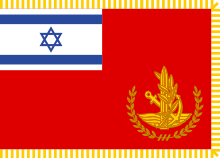Gadi Eizenkot
| Gadi Eizenkot | |
|---|---|
 Gadi Eizenkot, 2011 | |
| Native name | גדי איזנקוט |
| Born |
19 May 1960 Tiberias, Israel |
| Allegiance |
|
| Service/branch | Operations Directorate, Northern Command |
| Years of service | 1978– |
| Rank |
|
| Commands held | Commander of the Northern Command, Commander of the Golani Brigade, Military Secretary to the Prime Minister, Commander of the Judea and Samaria Division, Commander of the Operations Directorate |
| Battles/wars | |
Gadi Eizenkot (Hebrew: גדי איזנקוט; born May 19, 1960) is the Chief of General Staff of the Israel Defense Forces, taking the oath of office on February 16, 2015.
Early life
Eizenkot was born in 1960 in Tiberias, in northern Israel. He is the second of four children[1] to Ester and Meir,[2] Jewish Moroccan immigrants[3] from the town of Safi. His mother was born in Casablanca, and his father was born in Marrakesh.
Eizenkot grew up in the southern port city of Eilat, and studied in "Goldwater High School", majoring in naval studies, but later chose to enlist to Golani infantry brigade instead.[4]
Military career
After enlisting to the IDF Eizenkot was assigned to the Golani Brigade, which he himself would eventually command from 1997-98. He served as a soldier, a squad leader and a platoon commander. In the First Lebanon War he served as a Company commander in Golani brigade. During the South Lebanon conflict (1985–2000) he served as the brigade's Operations Officer and as the commander of the Golani Orev Company. Later, he served as the commander of 13th Battalion, the Deputy to the Commander of the Brigade and an operations officer of the Northern Command.[5] During that time he received a B.A. in history from Tel Aviv University and attended the United States Army War College for a master's degree.
In 1999 Eizenkot was selected to be the Military Secretary for the Prime Minister and the Minister of Defense under then Prime Minister Ehud Barak. Since then he has commanded the 366th Division and the Judea and Samaria Division, where he led the Campaign against Palestinian political violence. He was promoted to head of Israeli Operations Directorate in June 2005, and served as such during the Second Lebanon War.
After Maj. Gen. Udi Adam resigned in October 2006 amid criticism over his conduct in the 2006 Lebanon War, Eizenkot replaced him as head of the Northern Command.[6]
On July 11, 2011, the position was transferred to Maj. Gen. Yair Golan,[7] and Eizenkot went to study for a post-graduate degree at Haifa University in Political science. Afterwards he served as Deputy Chief of General Staff in place of Maj. Gen. Yair Naveh, assuming office on January 14, 2013. On November 28th, 2014, Defense Minister Moshe Ya’alon and Prime Minister Benjamin Netanyahu chose Eizenkot as the successor to Gen. Benny Gantz as the Chief of Staff of the IDF.
Strategic vision
Eizenkot developed his strategic vision during the years of his military service. During the Second Lebanon War he promoted the attack on Hezbollah headquarters and command and control center at the Dahiya quarter in Beirut. This attack took place only after early warning to make sure that uninvolved civilians are not harmed.[8] After the war Hezbollah has shifted their rocket and missile capabilities into more than 200 Shi'ite villages in south Lebanon. In response to the Hezbollah doctrine of firing short and medium range rockets on Israeli civilians from its own civilian areas and using civilians as human shields, Eizenkot developed a three-stage retaliation concept:
- The first stage is attacking targets of high value, according to the proportionality principle of international law
- The second stage is issuing an effective pre-strike early warning to the civilians in the relevant sectors with its high-value targets. The purpose of such warnings is to safeguard uninvolved civilians, enabling them to evacuate from military targets positioned by Hezbollah within their villages.
- The third stage: after confirming that the critical mass of civilians has been evacuated, the IDF commences an extensive attack on the targets within the constraints of the international law.
This concept that has been used during the Second Lebanon War has proved to be successful by practically providing years of quiet and prosperity, both in the Lebanese side of the border as well as the Israeli side.[9]
Awards and Decorations
References
- ↑ www.ereverev.co.il
- ↑ www.kikarhashabat.co.il
- ↑ The Israeli army gets its first Moroccan chief-of-staff - so why the Ashkenazi name?, Haaretz, by Elon Gilad, December 1, 2014.
- ↑ "New IDF chief: Cool and calculated, will strike hard and fast - but only if he must, Ynetnews, November 29, 2014.
- ↑ Maj. Gen. Gadi Eizenkot appointed Deputy to Chief of General Staff, IDF site (December 12, 2012).
- ↑ "Eisencott replaces Adam as OC Northern Command", Jerusalem Post, October 19, 2006. Retrieved October 21st, 2006.
- ↑ Maj. Gen. Yair Golan becomes new head of Northern Command, IDF site (July 11th, 2011).
- ↑ "Report of the United Nations Fact Finding Mission on the Gaza Conflict" (PDF). The Guardian. September 15, 2009. Retrieved 2009-09-15.
- ↑ Yaron London (June 10, 2008). "The Dahiya strategy". Ynetnews. Retrieved 2014-01-27.
External links
![]() Media related to Gadi Eizenkot at Wikimedia Commons
Media related to Gadi Eizenkot at Wikimedia Commons
| ||||||||
| ||||||
| ||||||
| ||||||||
